Effectiveness in Mitigating Forest Fire Ignition Sources: A Statistical Study Based on Fire Occurrence Data in China
Abstract
1. Introduction
2. Materials and Methods
3. Results
3.1. Characteristics of Forest Fire Causes and Their Distribution Patterns
3.2. Analysis of the Key Factors Responsible for the Drop in Fire Numbers
4. Discussion
5. Conclusions
Author Contributions
Funding
Institutional Review Board Statement
Informed Consent Statement
Data Availability Statement
Acknowledgments
Conflicts of Interest
Abbreviations
| ARS | arson |
| BCF | burning surface fuels to create fuelbreaks |
| BGW | burning the grass in wasteland (uncultivated land) to produce charcoal |
| BJP | burning joss paper at a grave site |
| BMB | burning the mountain to repel beasts |
| BPL | burning pasture to generate fertile land |
| BSA | burning slash in the mountains for afforestation |
| CHW | cooking and heating in wildland |
| CPF | children playing with fire |
| FAA | fire use in agricultural activities |
| FBS | failure of train brake shoes |
| FNA | fire from a neighboring area/county |
| FNC | fire from a neighboring country |
| FPD | fire ignited by people with dementia |
| FRH | fire escape from a resident house |
| FUA | fire use in nonagricultural activities |
| KLN | kilning |
| LTN | lightning |
| MODIS | moderate resolution imaging spectroradiometer |
| NIS | natural ignition source |
| OFA | the others in the category of fire use in agricultural activities |
| OFN | the others in the category of fire use in nonagricultural activities |
| OHR | other human related causes |
| PLL | power line lodging |
| SFV | spitfire by a machinery propelled vehicle |
| SMK | smoking in wildland |
| SPC | spontaneous combustion |
| TFL | train fire leak |
| UNF | unidentified fire cases |
| VIIRS | visible infrared imaging radiometer suite |
References
- Pyne, S.J.; Andrews, P.L.; Laven, R.D. Introduction to Wildland Fire; John Wiley and Sons: Chichester, UK, 1996. [Google Scholar]
- Yao, S.-R.; Wen, D.-Y. Principles of Forest Fire Protection Management; China Forestry Press: Beijing, China, 2002; pp. 21–24. [Google Scholar]
- Maingi, J.K.; Henry, M.C. Factors influencing wildfire occurrence and distribution in eastern Kentucky, USA. Int. J. Wildland Fire 2007, 16, 23–33. [Google Scholar] [CrossRef]
- Ganteaume, A.; Camia, A.; Jappiot, M.; San Miguel-Ayanz, J.; Long-Fournel, M. A review of the main driving factors of forest fire ignition over Europe. Environ. Manag. 2013, 51, 651–662. [Google Scholar] [CrossRef] [PubMed]
- Wang, H.-H. Exploration of the fire phenomena and countermeasures at the wildland and urban interface. Forest Fire Prev. 2008, 4, 13–15. (In Chinese) [Google Scholar]
- Ye, J.-X.; Wu, M.-S.; Deng, Z.-J.; Xu, S.-J.; Zhou, R.-L.; Clarke, K.C. Modeling the spatial patterns of human wildfire ignition in Yunnan province, China. Appl. Geogr. 2017, 89, 150–162. [Google Scholar] [CrossRef]
- Robertson, A. Investigators Confirm that PG&E Power Lines Started the Deadly Camp Fire. The Verge [15-05-2019]. Available online: https://www.theverge.com/2019/5/15/18626819/cal-fire-pacific-gas-and-electric-camp-fire-power-lines-cause (accessed on 5 November 2021).
- Tian, X.; Zhao, F.; Shu, L.; Wang, M. Distribution characteristics and the influence factors of forest fires in China. Forest Ecol. Manag. 2013, 310, 460–467. [Google Scholar] [CrossRef]
- Rodrigues, M.; Jiménez-Ruano, A.; Peña-Angulo, D.; de la Riva, J. A comprehensive spatial-temporal analysis of driving factors of human-caused wildfires in Spain using geographically weighted logistic regression. J. Environ. Manag. 2018, 225, 177–192. [Google Scholar] [CrossRef] [PubMed]
- Chas-Amil, M.; Prestemon, J.; Mc Clean, C.; Touza, J. Human-ignited wildfire patterns and responses to policy shifts. Appl. Geogr. 2015, 56, 164–176. [Google Scholar] [CrossRef]
- Fusco, E.J.; Abatzoglou, J.T.; Balch, J.K.; Finn, J.T.; Bradley, B.A. Quantifying the human influence on fire ignition across the western USA. Ecol. Appl. 2016, 26, 2390–2401. [Google Scholar] [CrossRef] [PubMed]
- Zhang, Z.; Li, J.; Yu, S.; Zhao, J. Spatial accessibility of anthropogenic fire ignition sources of grassland fire in northeast China. Int. J. Wildland Fire 2021, 30, 763–775. [Google Scholar] [CrossRef]
- Wang, H.-H. Outstanding achievements and core management mechanisms of forest fire prevention in China. Forest Fire Prev. 2019, 3, 1–8. (In Chinese) [Google Scholar]
- Wang, H.-H.; Finney, M.A.; Song, Z.-L.; Wang, Z.-S.; Li, X.-C. Ecological techniques for wildfire mitigation: Two distinct fuelbreak approaches and their fusion. Forest Ecol. Manag. 2021, 495, 119376. [Google Scholar] [CrossRef]
- National Interagency Fire Center. Fire Information—Statistics. Available online: https://www.nifc.gov/fireInfo/fireInfo_statistics.html (accessed on 10 June 2019).
- Dello, K. Prepare for larger, longer wildfires. Colum: World View. Nature 2017. [Google Scholar] [CrossRef]
- State Forestry and Grassland Administration. Annual Development Report. Available online: http://www.forestry.gov.cn/main/62/index.html (accessed on 10 June 2019).
- Statistical Yearbook Sharing Platform. China Forestry Statistical Yearbook (2003–2017). Available online: http://www.yearbookchina.com (accessed on 3 November 2021).
- MODIS. Active Fire and Burnt Area Products. Available online: http://www.modis-fire.umd.edu (accessed on 18 November 2022).
- Visible Infrared Imaging Radiometer Suite (VIIRS)—LAADS DAAC. Available online: https://ladsweb.modaps.eosdis.nasa.gov/missions-and-measurements/viirs/ (accessed on 30 November 2022).
- Guo, F.; Su, Z.; Wang, G.; Sun, L.; Lin, F.; Liu, A. Wildfire ignition in the forests of southeast China: Identifying drivers and spatial distribution to predict wildfire likelihood. Appl. Geogr. 2016, 66, 12–21. [Google Scholar] [CrossRef]
- Ministry of Emergency Management of the People’s Republic of China. Briefing of National Natural Disasters in 2020. Available online: https://www.mem.gov.cn/xw/yjglbgzdt/202101/t20210108_376745.shtml (accessed on 8 January 2022).
- Tian, F.-Q. Strengthen the sense of responsibility, fully implement the system of forest fire prevention chief executive responsibility. Forest Fire Prev. 2015, 1, 12–15. (In Chinese) [Google Scholar]
- Wei, S.-J.; Luo, B.-Z.; Li, X.-C.; Wu, Z.-P.; Wang, Z.-S.; Zhou, Y.-F.; Hu, H.-Q.; Sun, L.; Luo, S.-S.; Zhong, Y.-X. Strengthen the supervision of forest fire prevention and consolidate the responsibility for forest fire prevention at the grassroots level. Forest Fire Prev. 2019, 1, 1–5, 14. (In Chinese) [Google Scholar]
- Cohen, J.D.; Saveland, J. Structure ignition assessment can help reduce fire damages in the W-UI. Fire Manag. Notes 1997, 57, 19–23. [Google Scholar]
- Zhou, S.-R. Talking about the publicity and education of forest fire prevention in ecotourism. Forest Fire Prev. 2017, 4, 21–23. (In Chinese) [Google Scholar]
- Ministry of Emergency Management of the People’s Republic of China. Briefing of National Natural Disasters in 2019. Available online: https://www.mem.gov.cn/xw/bndt/202001/t20200116_343570.shtml (accessed on 16 January 2022).

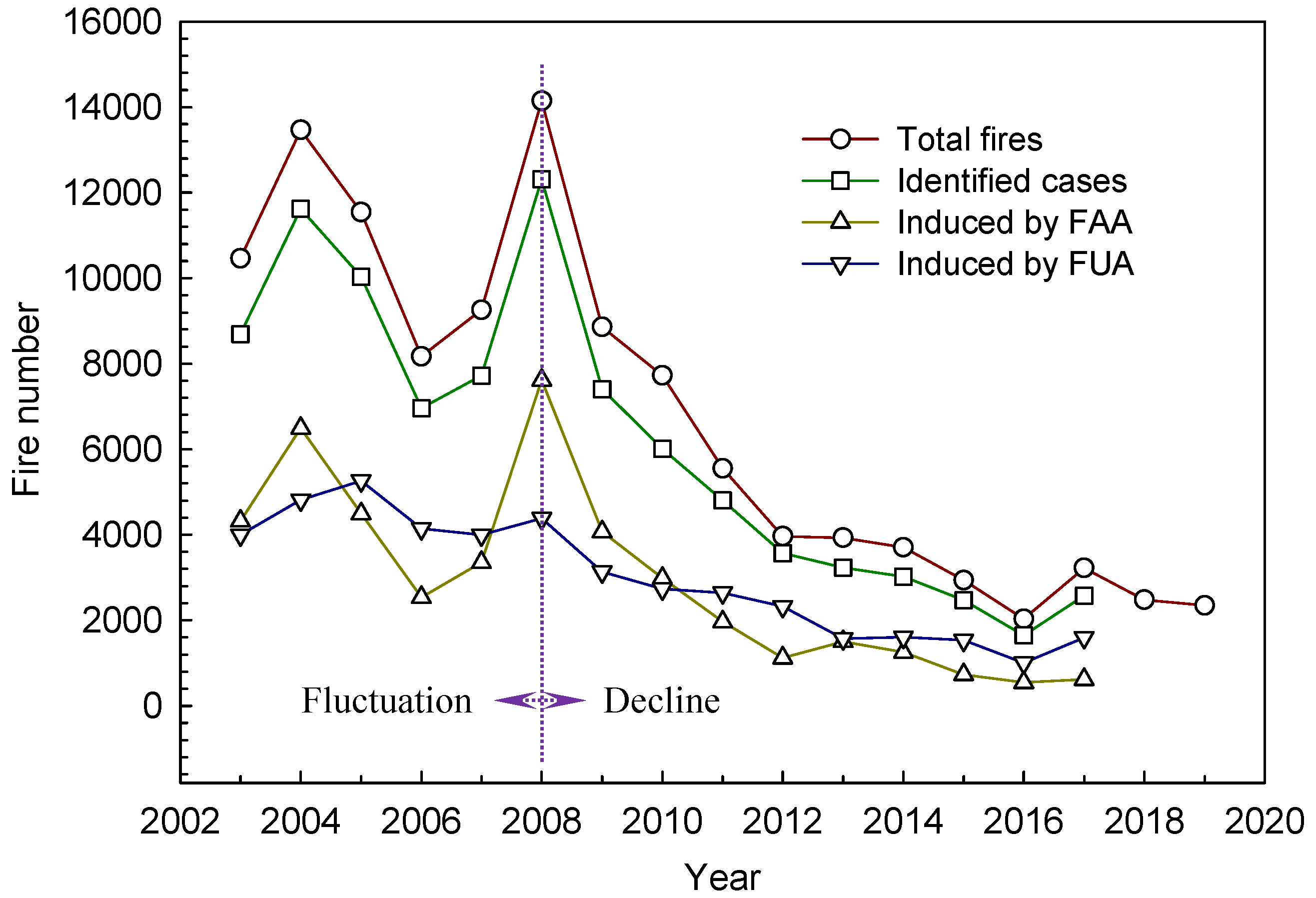
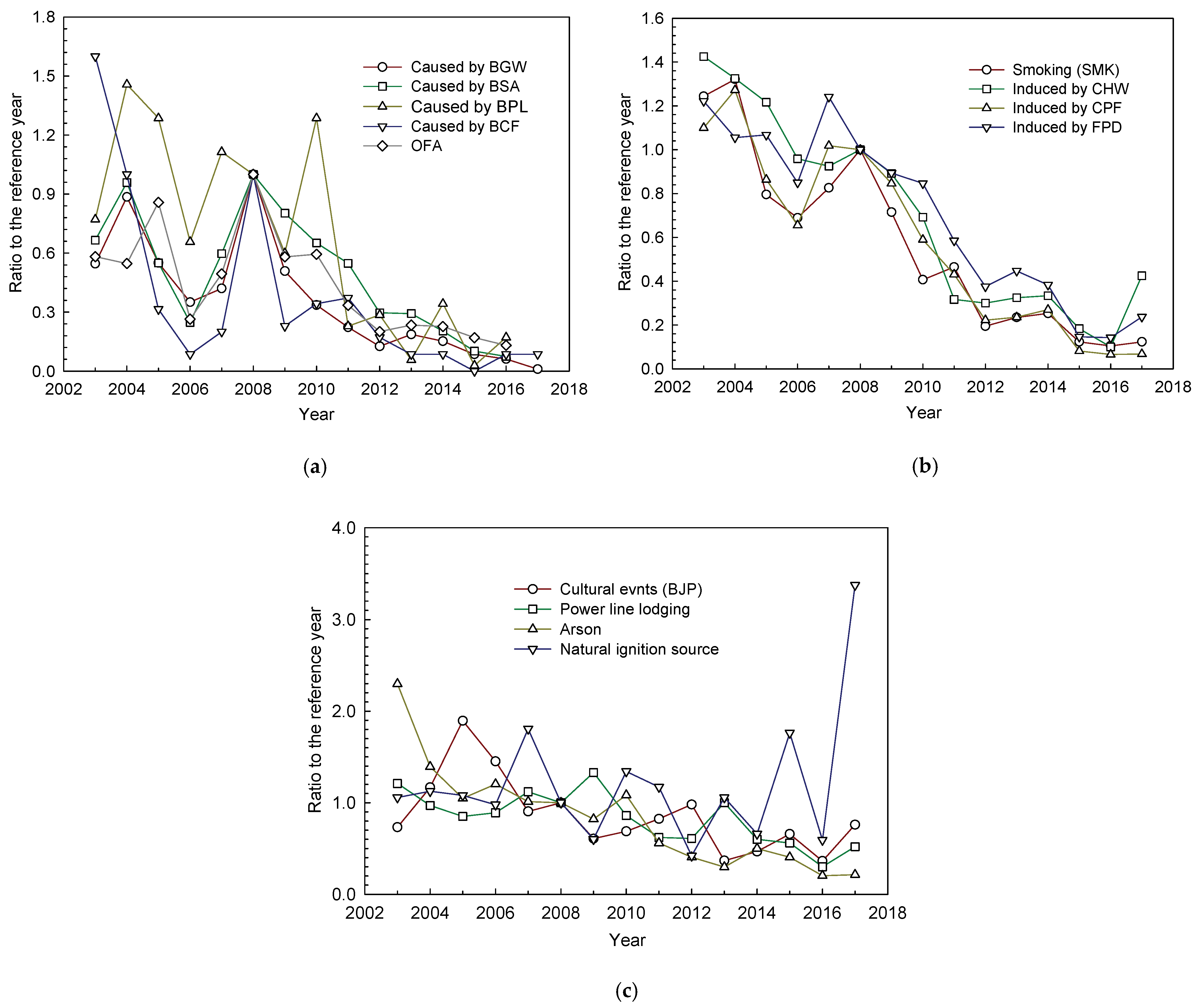
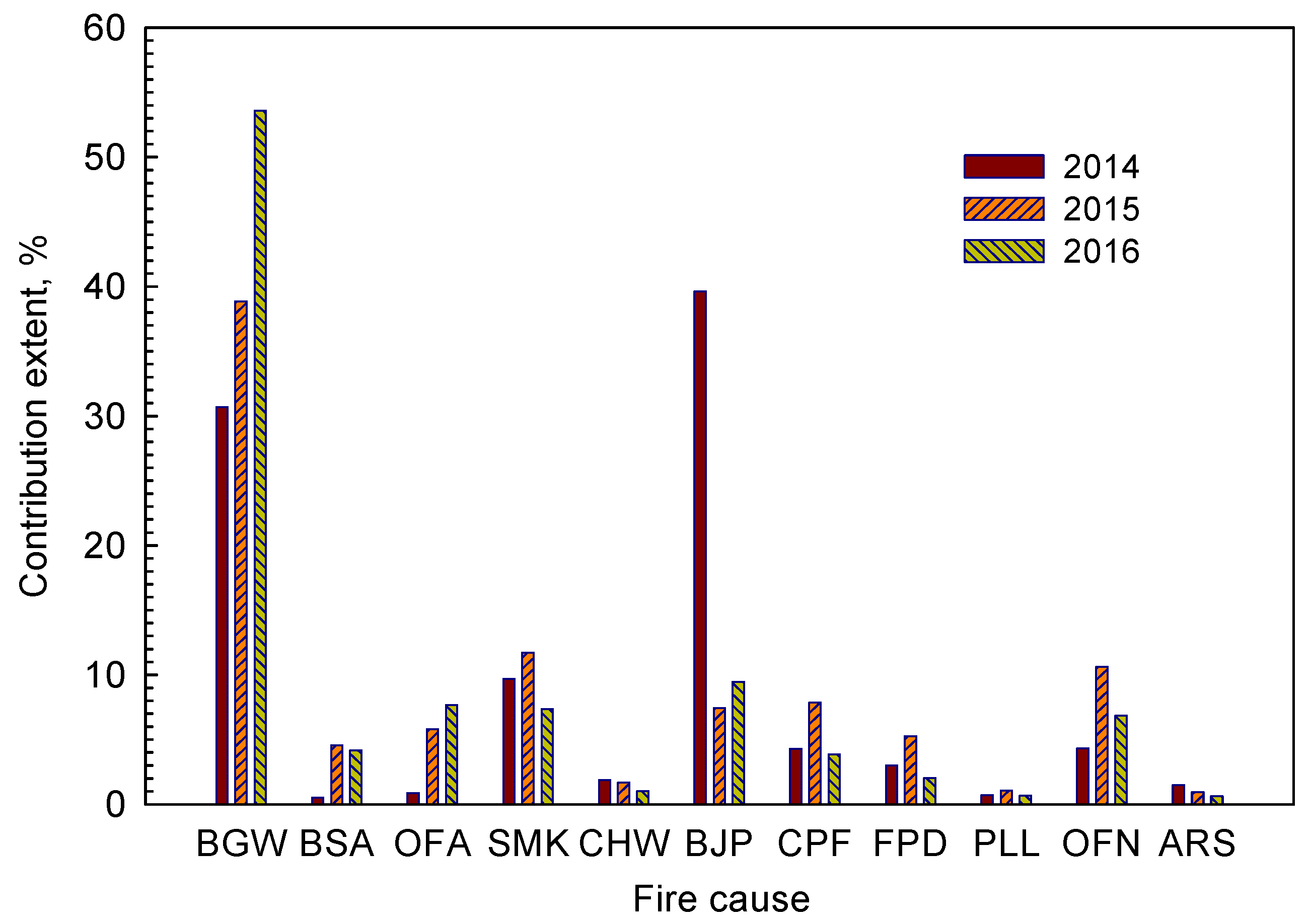
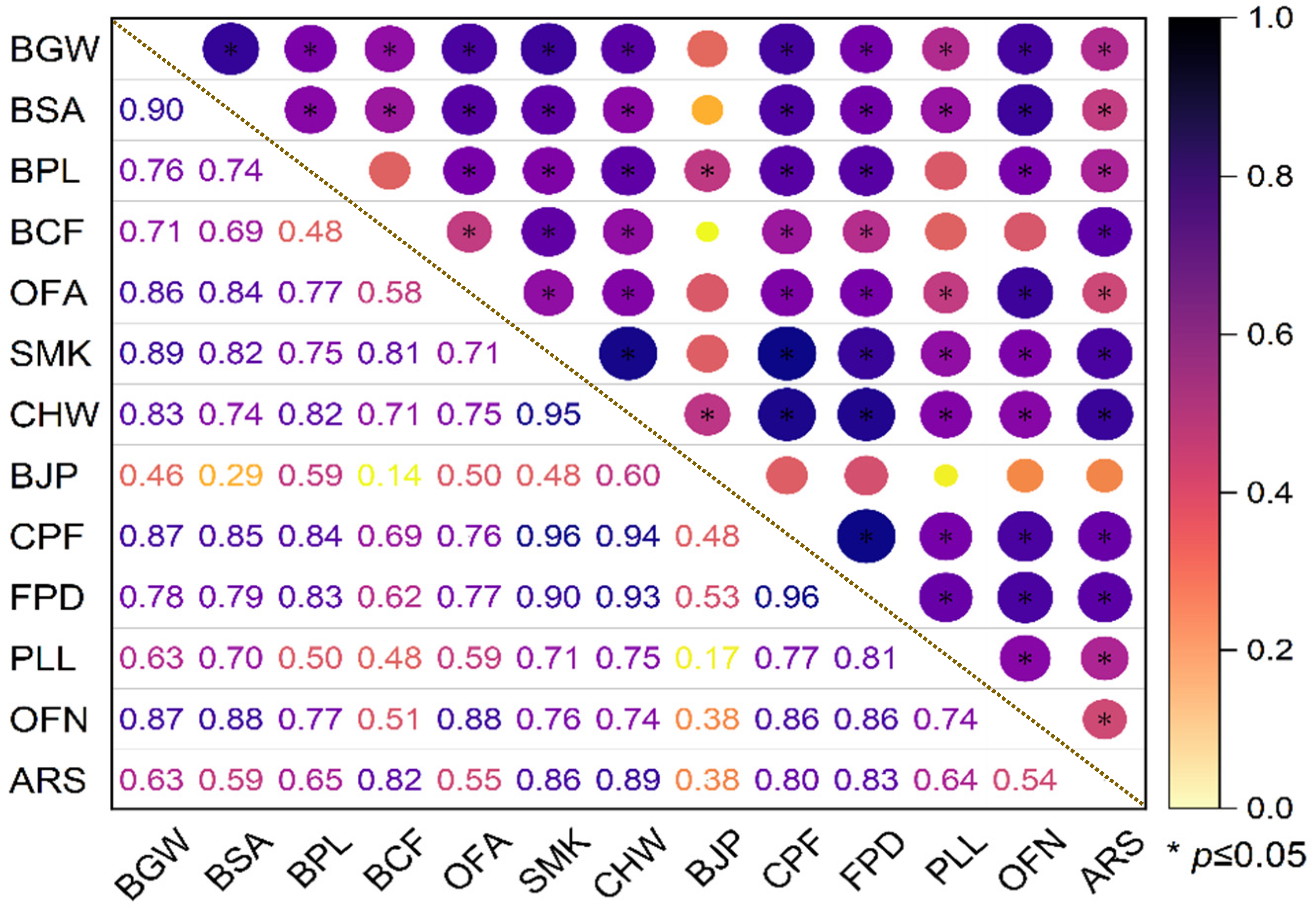
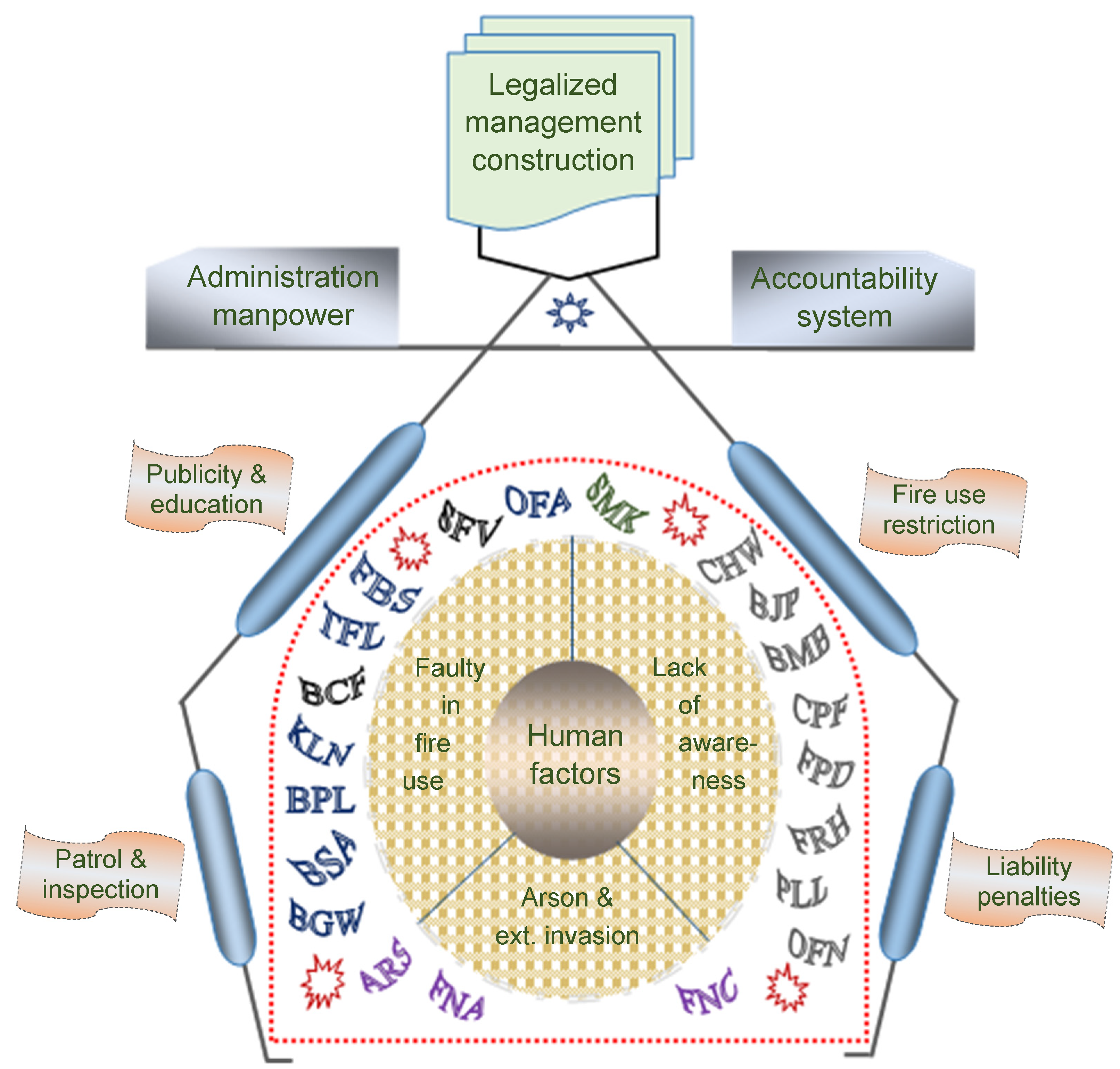
| Fire Num. | Identified Fire Incidents | Unidentified | |||||||||
|---|---|---|---|---|---|---|---|---|---|---|---|
| Fire Use in Agricultural Activity | Fire Use in Non-Agricultural Activity | Other Human Related Ignition Cause | Natural Ignition Source | ||||||||
| Case | Perc. % | Case | Perc. % | Case | Perc. % | Case | Perc. % | Case | Perc. % | ||
| 2003 | 10,463 | 4320 | 41.3 | 3995 | 38.2 | 285 | 2.7 | 93 | 0.9 | 1770 | 16.9 |
| 2004 | 13,466 | 6494 | 48.2 | 4816 | 35.8 | 214 | 1.6 | 99 | 0.7 | 1843 | 13.7 |
| 2005 | 11,542 | 4492 | 38.9 | 5260 | 45.6 | 187 | 1.6 | 95 | 0.8 | 1508 | 13.1 |
| 2006 | 8170 | 2538 | 31.1 | 4144 | 50.7 | 191 | 2.3 | 86 | 1.1 | 1211 | 14.8 |
| 2007 | 9260 | 3354 | 36.2 | 3996 | 43.2 | 215 | 2.3 | 159 | 1.7 | 1536 | 16.6 |
| 2008 | 14,144 | 7617 | 53.9 | 4380 | 31.0 | 226 | 1.6 | 88 | 0.6 | 1833 | 13.0 |
| 2009 | 8859 | 4070 | 45.9 | 3131 | 35.3 | 156 | 1.8 | 53 | 0.6 | 1449 | 16.4 |
| 2010 | 7723 | 2981 | 38.6 | 2734 | 35.4 | 175 | 2.3 | 118 | 1.5 | 1715 | 22.2 |
| 2011 | 5550 | 1966 | 35.4 | 2642 | 47.6 | 92 | 1.7 | 103 | 1.9 | 747 | 13.5 |
| 2012 | 3966 | 1121 | 28.3 | 2320 | 58.5 | 88 | 2.2 | 37 | 0.9 | 400 | 10.1 |
| 2013 | 3929 | 1505 | 38.3 | 1571 | 40.0 | 65 | 1.7 | 93 | 2.4 | 695 | 17.7 |
| 2014 | 3703 | 1254 | 33.9 | 1606 | 43.4 | 99 | 2.7 | 58 | 1.6 | 686 | 18.5 |
| 2015 | 2936 | 729 | 24.8 | 1535 | 52.3 | 49 | 1.7 | 155 | 5.3 | 468 | 15.9 |
| 2016 | 2034 | 547 | 26.9 | 1006 | 49.5 | 41 | 2.0 | 52 | 2.6 | 388 | 19.1 |
| 2017 | 3223 | 618 | 19.2 | 1594 | 49.5 | 65 | 2.0 | 297 | 9.2 | 649 | 20.1 |
| 2018 | 2478 | n/a * | n/a | n/a | n/a | n/a | |||||
| 2019 | 2345 | n/a | n/a | n/a | n/a | n/a | |||||
| FAA * | FUA ** | OHR *** | |||||||||||||||||||
|---|---|---|---|---|---|---|---|---|---|---|---|---|---|---|---|---|---|---|---|---|---|
| BGW | BSA | BPL | KLN | BCF | TFL | FBS | SFV | OFA | SMK | CHW | BJP | BMB | CPF | FPD | FRH | PLL | OFN | ARS | FNA | FNC | |
| 2003 | 3325 | 321 | 27 | 21 | 56 | 12 | 0 | 10 | 548 | 1092 | 171 | 1162 | 89 | 485 | 309 | 14 | 121 | 552 | 193 | 73 | 19 |
| 2004 | 5394 | 462 | 51 | 22 | 35 | 7 | 0 | 8 | 515 | 1160 | 159 | 1853 | 56 | 561 | 267 | 16 | 97 | 647 | 117 | 89 | 8 |
| 2005 | 3350 | 265 | 45 | 7 | 11 | 2 | 0 | 4 | 808 | 698 | 146 | 3006 | 53 | 381 | 270 | 8 | 85 | 613 | 88 | 95 | 4 |
| 2006 | 2134 | 119 | 23 | 3 | 3 | 1 | 0 | 6 | 249 | 605 | 115 | 2303 | 36 | 289 | 215 | 12 | 89 | 480 | 101 | 71 | 19 |
| 2007 | 2561 | 288 | 39 | 6 | 7 | 1 | 0 | 6 | 466 | 725 | 111 | 1435 | 51 | 449 | 314 | 20 | 112 | 779 | 85 | 120 | 10 |
| 2008 | 6093 | 482 | 35 | 10 | 35 | 6 | 9 | 5 | 942 | 878 | 120 | 1587 | 32 | 441 | 253 | 22 | 100 | 947 | 84 | 136 | 6 |
| 2009 | 3097 | 387 | 21 | 7 | 8 | 1 | 1 | 1 | 547 | 628 | 107 | 964 | 33 | 373 | 226 | 19 | 133 | 648 | 69 | 78 | 9 |
| 2010 | 2046 | 314 | 45 | 2 | 12 | 0 | 1 | 1 | 560 | 357 | 83 | 1091 | 20 | 260 | 214 | 5 | 86 | 618 | 91 | 74 | 10 |
| 2011 | 1357 | 264 | 8 | 5 | 13 | 1 | 1 | 2 | 315 | 408 | 38 | 1307 | 27 | 190 | 148 | 13 | 62 | 449 | 47 | 42 | 3 |
| 2012 | 769 | 143 | 10 | 1 | 6 | 0 | 1 | 2 | 189 | 171 | 36 | 1556 | 16 | 98 | 95 | 9 | 61 | 278 | 34 | 45 | 9 |
| 2013 | 1135 | 141 | 2 | 1 | 3 | 0 | 0 | 3 | 220 | 206 | 39 | 583 | 8 | 104 | 113 | 7 | 100 | 411 | 25 | 39 | 1 |
| 2014 | 925 | 98 | 12 | 1 | 3 | 0 | 0 | 1 | 214 | 222 | 40 | 741 | 10 | 119 | 97 | 8 | 60 | 309 | 42 | 52 | 5 |
| 2015 | 518 | 49 | 1 | 0 | 0 | 0 | 0 | 1 | 160 | 108 | 22 | 1044 | 7 | 36 | 37 | 4 | 56 | 221 | 34 | 12 | 3 |
| 2016 | 376 | 36 | 6 | 1 | 3 | 0 | 0 | 1 | 124 | 92 | 12 | 576 | 9 | 29 | 36 | 8 | 30 | 214 | 17 | 24 | 0 |
| 2017 | n/a ** | 60 | n/a | n/a | 3 | n/a | n/a | n/a | n/a | 108 | 51 | 1205 | n/a | 30 | 60 | n/a | 52 | n/a | 18 | 39 | 8 |
Publisher’s Note: MDPI stays neutral with regard to jurisdictional claims in published maps and institutional affiliations. |
© 2022 by the authors. Licensee MDPI, Basel, Switzerland. This article is an open access article distributed under the terms and conditions of the Creative Commons Attribution (CC BY) license (https://creativecommons.org/licenses/by/4.0/).
Share and Cite
Wang, H.; Jin, B.; Zhang, K.; Aktar, S.; Song, Z. Effectiveness in Mitigating Forest Fire Ignition Sources: A Statistical Study Based on Fire Occurrence Data in China. Fire 2022, 5, 215. https://doi.org/10.3390/fire5060215
Wang H, Jin B, Zhang K, Aktar S, Song Z. Effectiveness in Mitigating Forest Fire Ignition Sources: A Statistical Study Based on Fire Occurrence Data in China. Fire. 2022; 5(6):215. https://doi.org/10.3390/fire5060215
Chicago/Turabian StyleWang, Haihui, Bangxin Jin, Kaixuan Zhang, Shamima Aktar, and Zhilong Song. 2022. "Effectiveness in Mitigating Forest Fire Ignition Sources: A Statistical Study Based on Fire Occurrence Data in China" Fire 5, no. 6: 215. https://doi.org/10.3390/fire5060215
APA StyleWang, H., Jin, B., Zhang, K., Aktar, S., & Song, Z. (2022). Effectiveness in Mitigating Forest Fire Ignition Sources: A Statistical Study Based on Fire Occurrence Data in China. Fire, 5(6), 215. https://doi.org/10.3390/fire5060215







